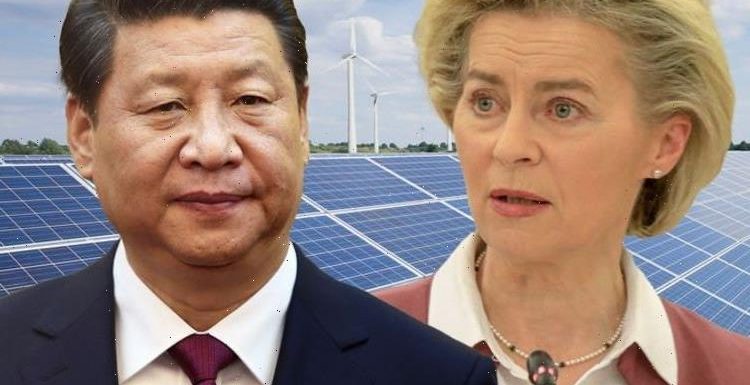
China: UK must put 'conditions' on trade says Tory MP
We use your sign-up to provide content in ways you’ve consented to and to improve our understanding of you. This may include adverts from us and 3rd parties based on our understanding. You can unsubscribe at any time. More info
The European Commission has said that the EU is now planning to mobilise €2.4billion (£2.04billion) grants for Sub-Saharan Africa and €1.08billion (£920million) for North Africa to support renewable energy. This includes the production of renewable hydrogen, which the Commission says can help meet the EU’s projected skyrocketing demand for the clean energy source.
Brussels will ask partner countries to commit to trade hydrogen freely “without export restrictions or price distortions” as the world races to meet emissions targets in the battle against the climate crisis.
Governments have recognised that the Sahara Desert in North Africa can generate a load of renewable energy due to its dry climate and vast expanses.
The EU views hydrogen as one of the core instruments it could use to help the bloc transition away from fossil fuels and 2020.
The EU’s 2020 hydrogen strategy within the framework of the European Green Deal (EGD) proposes shifting to green hydrogen by 2050 by not just creating it locally but also by getting its supply from Africa.
But the EU’s new planned strategy for North Africa is actually part of the bloc’s wider €300billion (£255billion) plan, dubbed “Global Gateway” to take on China by outbidding it in global infrastructure projects.
The EU’s plan to mobilise the public and private funds by 2027 to finance the blocs EU infrastructure abroad appears to be a similar strategy to China’s Belt and Road initiative.


This is the Chinese government’s strategy that was taken on in 2013 to invest in infrastructure projects across nearly 70 countries and international organizations, as well as create new trade routes, and help China to establish more economic and political influence around the world.
While the EU’s plan doesn’t mention Chinese President Xi Jinping’s Belt and Road project by name, the document detailing the plan suggests that Global Gateway is a democratic alternative to China’s masterplan.
The document on Global Gateway says it “aims to forge links and not create dependencies”.
It continues that democracies “must have the ambition needed to help improve people’s lives around the world” and on the ground”.
And while the EU has only just drafted up the plan to support renewable technologies in Africa, it appears to be playing catch-up with China.
According to the International Renewable Energy Agency, between 2009 and 2018, China upgraded Africa’s solar capacity from 739 megawatts to 5,500 megawatts.

And wind energy installations over that same period soared from 108 to 6,100 megawatts.
Adhere Cavince, an international relations scholar who writes about China-Africa relations, said: “China has been the leading partner in the continent’s desire to switch to solar and wind energy.”
It appears that the EU is now racing to combat China’s influence in the region through introducing more hydrogen in the region.
But while it has been suggested it is a battle for influence in the region, it may also be to help Europe fulfil its own climate targets.
The International Renewable Energy Agency made a renewable energy roadmap for Africa for 2030 which indicates that there is the potential for an expansion in capacity of 70 GW of wind and 50 GW of concentrated solar power and PV in North Africa.
African Business reported: “Europe is now hoping that existing pipelines can be converted and new pipelines to transport green hydrogen from North Africa to Europe can be built.
DON’T MISS
Bermuda Triangle bombshell as probe uncovered 80-year-old shipwreck [REVEAL]
Archaeology breakthrough as 11-year-old finds ‘rare’ silver coin [REPORT]
Putin’s plot ‘dead in water’ a Germany slams breaks on gas [INSIGHT]


North African countries could be the early adopters in the African Union to supply green hydrogen to Europe because of their resource’s potential, proximity and existing trade relations.”
But hydrogen also features as a core part of China’s climate strategy too.
And currently, Chinese manufacturers are reportedly ahead of Europe in the low-cost manufacturing of hydrogen production equipment, with their electrolysers costing only a fraction of European ones.
A source at a prominent European electrolyser manufacturer told Clean Energy Wire: “We see China as an important green hydrogen competitor because the country established it early on as a core element of its climate plan.
“European manufacturers clearly lead the way when it comes to efficiency, scalability and flexibility, while Chinese competitors use simpler technologies, but enjoy cost advantages.”
Source: Read Full Article